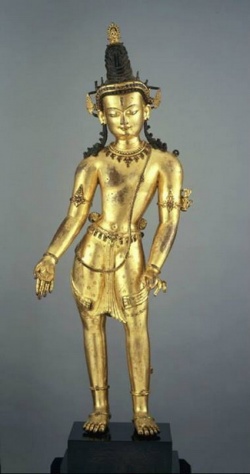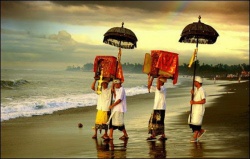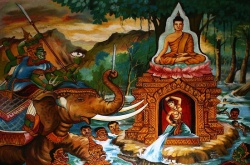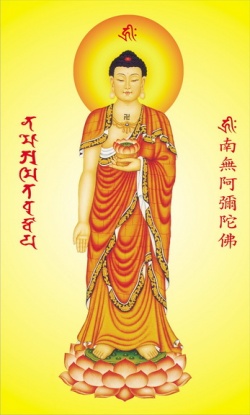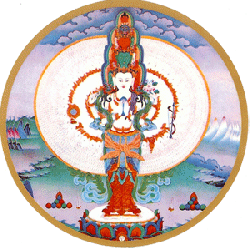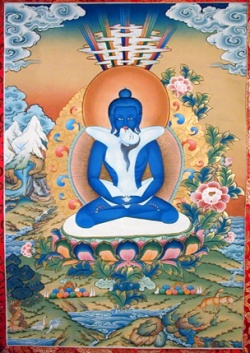Buddhism in Mahāsāṃghika
Early Development
Traditional accounts differ on the occasion and reason for the schism that gave rise to the Mahāsāṃghika. Some accounts claim that the Mahās-āṃghika separated from the Sthavira at the time of the Second Buddhist Council (Vaiśālī, c. 340 BCE), others, that it occurred during a third council (sometimes confused with the Third Council held at Pāṭaliputra under King Aśoka, 244 BCE). The reasons for the schism have also been much debated. It is agreed that the split was motivated by matters of monastic discipline, but scholars disagree on the precise issues at stake. Most Western scholars are inclined to accept that the Mahāsāṃghika represented the more lax position in matters of discipline. Less common is the position of those who would claim the opposite, pointing to the fact that the Mahāsāṃghika had a very conservative Vinaya and that its Prātimokṣa was as strict as that of other Hīnayāna schools. It seems therefore unlikely that laxness in monastic regulations was the motive for the split.
Moreover, recent scholarship tends to distinguish the dispute that provoked the Second Council, which ended in reconciliation in the order, from a dispute that probably occurred shortly thereafter (anywhere between sixteen and sixty years later). It was this latter dispute that produced the schism that divided the Hīnayāna schools into its two major camps, the Sthaviras and the Mahāsāṃghikas. Be that as it may, it seems obvious that the Mahāsāṃghika criticized the arhat ideal and exalted the image of the Buddha, turning the historical life of the founder into an event of secondary importance and the arhat ideal into an inferior goal. In this sense they were making an argument against tradition, and whatever the significance of their Vinaya may be, their doctrinal positions were clearly innovative.
Literature
The Mahāsāṃghika tendency to innovate can be seen also in the content and structure of their Tripiṭaka. Although in its early stages it is believed to have been comprised of only three parts (Sūtra, Vinaya, and Abhidharma), the Sūtra Piṭaka was later expanded so that the Kṣudraka Āgama became a separate Piṭaka called Saṃyukta Piṭaka. According to some sources this section came to include "vaipulya sūtras," an expression that could refer to Mahāyāna texts. The last addition to the Mahāsāṃghika Tripiṭaka was a fifth section, the Dhāraṇī Piṭaka, a collection of spells and incantations. Some accounts, however, say that the fifth Piṭaka was a Bodhisattva Piṭaka, which presumably refers to a collection of Mahāyāna texts.
Unfortunately, little remains of this canon and it is now impossible to confirm or even clarify such general statements. The Prātimokṣa of the Mahāsāṃghika survives in its original Sanskrit, and part of the Vinaya survives in the Sanskrit work Mahāvastu, which claims in its colophon to be a work of the Lokottaravādin Mahāsāṃghika of Central India. Apart from these and a few fragments of the Vinaya and the Sūtra section of their canon found at Bāmiyān, the rest of the Indian texts of the school are lost. Even in translation only a few texts survive. There is a Chinese translation of their Vinaya by Faxian, and what seems to be part of their Sūtra Piṭaka (Ekottarāgama). The latter text appears to be a translation from a prakritic language. There is also a distinct Mahāsāṃghika influence on a Dharmaguptaka text, the Śāriputrābhidharma Śāstra.
The Mahāvastu—the Buddhist Hybrid Sanskrit text of which was preserved in Nepal as a Mahāyāna Sūtra—represents only that section of the Vinaya that establishes the "historical" basis for monastic institutions, that is, the life and early ministry of the Buddha. It is primarily a biography of the Buddha from his meeting with Dīpaṃkara to his first sermon and the conversion of the first disciples. It also contains a number of avadānas. But it contains no material on matters of monastic discipline and its main narrative is interpolated with numerous digressions, mostly stories of the jātaka or avadāna genre. Although the oldest portions of this work must go back to the early stages of the formation of canonical Buddhism, it contains numerous late interpolations that place the extant recension in the fifth century CE.
Although the Mahāvastu is regarded as a transitional work, for the most part it does not show doctrinal leanings radically distinct from those of most Vinayas. There are, however, a few clear signs of those elements of doctrine and language that have been traditionally considered characteristics of Mahāsāṃghika, some of which also define Mahāyāna. The text speaks of the Buddha's lokottara ("supramundane") status, of his presence in the world only by dint of an illusion created in order to conform to the aspirations and perceptions of living beings. The fact that the Mahāvastu is written in Hybrid Sanskrit would seem to confirm the tradition according to which the Mahāsāṃghika used some form of Prakrit in their religious literature.
Doctrinal Developments
The most characteristic doctrine of the Mahāsāṃghika group are the famous "Five Points of Mahādeva" (sometimes attributed to a certain Bhadra), an attack on the arhat that has been the object of at least two interpretations: it can be regarded as an argument for more lax moral standards or it can be seen as an indirect way of arguing for the value of the bodhisattva ideal. These five points are (1) that an arhat can be seduced by another (para-upahṛta—meaning that he can have nocturnal emissions accompanied by an erotic dream); (2) that ignorance (ajñāna) is not totally absent in an arhat (his spiritual insight does not give him knowledge of profane matters); (3) that an arhat can have doubts (kaṃkṣā); (4) that an arhat can be surpassed by another (para-vitīrṇa—a term of obscure meaning); and (5) that an arhat can enter the higher stages of the path by uttering a phrase (vacibheda) such as "Oh, sorrow!" The exact meaning of these doctrines is far from obvious. Even the general intent is not transparent; one may ask if the Five Points imply that the arhat is more human than he was thought to be in other schools, or that he is weaker than others believe. Or is the implication that the bodhisattva path is superior?
Other doctrines attributed to the Mahāsāṃghika are equally tantalizing. For instance, it is said that they held that only prajñā liberates, a thesis that may reflect an early emphasis on prajñā such as would have led to the eventual centrality of the Perfection of Wisdom (Prajñāpāramitā) literature in Mahāyāna. The Mahāsāṃghika seem also to have claimed that all word of the Buddha are nītārtha; that is, they are in no need of interpretation. But this may mean not so much that the canon needs no exegesis as that the Buddha when he preaches has no hidden intent except for what living beings may find in his words, according to their capacities. At least this would be the only way this doctrine could accord with other statements attributed to the Mahāsāṃghikas, for they held that the Buddha preaches all dharmas with one word, that he preaches even when he does not speak, and that there is no conventional truth (saṃvṛtti-satya) in his Dharma.
Buddhology
Also characteristic of the Mahāsāṃghika is the belief that there are many Buddhas in all of the ten directions and at all times in the past, the present, and the future. In this they differ from more conservative Buddhists who believe that a Buddha is a rare phenomenon. But the Mahāsāṃghika claim may be another side of the doctrine that has been called "Buddhist docetism," that is, the belief that Buddhas do not lead a human life, even when they seem to be appearing in history. Perhaps related to this doctrine is the notion that bodhisattvas make a vow (praṇidhāna) to remain in the cycle of transmigration for the sake of sentient beings. They prolong their stay voluntarily; in fact, bodhisattvas may choose a life in hell for the sake of living beings.
Sectarian Outgrowths
Of the various sects that issued from the Mahāsāṃghika, the most important are the Lokottaravādins and the Prajñaptivādins. It has been suggested that these two branches represent two major doctrinal departures as well as two geographical centers of activity. Although both branches and their derivatives were active in more than one part of India, the Lokottaravādin group centered in the North (Mathura), the Prajñaptivādin groups in the southeast of India. It also seems that the northern groups preferred Sanskrit as their canonical language, whereas the groups in the South used Prakrit. Doctrinally, however, the distinction is difficult to maintain, since the traditional sources are often contradictory.
Lokottaravā
The Lokottaravādins seem to have emphasized the general docetic tendencies of the Mahāsāṃghika more than did the other subschools. Unfortunately, as the sources seem to conflate all doctrines of the Mahāsāṃghika splinter groups into their general description of the Mahāsāṃghika, it is difficult to distinguish one from the other or from the parent school. The tenet from which the Lokottaravā derives its name, the belief that the "career," or sequence of lives leading to and including the complete enlightenment of Buddhas, is only a series of apparitional events, is also attributed to the main school. According to this doctrine, Buddhas are supramundane; that is, they are not human beings but perfectly pure spiritual beings, free from the limitations of a physical body. This doctrine can be recognized in at least one key passage in the Mahāvastu, but it is far from being the dominant theme in that work. This does not necessarily prove that the belief was not as central to the school as claimed by the doxographers. It may be that much of the Mahāsāṃghika doctrinal speculation took place in the Abhidharma and the commentarial literature of the school—all of which is now lost. The monastic, meditational, and liturgical life of the communities probably did not reflect the doctrinal rifts that defined the schools.
Prajñaptivāda
In contrast to the general Mahāsāṃ-ghika view, this subschool held that all statements of doctrine are merely of provisional or purely conventional meaning. Still, the Prajñaptivādins appear to have preserved some distinction between absolute and relative truths. In spite of the obscurity of this notion, one can see the connection between it and certain ideas of the Bahuśrutīyas. This may be due to a common origin from the Gokulika branch of the Mahāsāṃghika.
From the Prajñaptivāda arose other groups, the most important being the Aparaśailas and the Pūrvaśailas, whose main center of activity was in Dhānyakaṭaka (modern Andhra Pradesh). They seem to have counted in their literature some works of Mahāyāna tendency, perhaps even Prajñāpāramita texts in Prakrit.
If the Bahuśrutīya school is also an offshoot of the parent Mahāsāṃghika line then we would have to count among Mahāsāṃghika literature Harivarman's scholastic treatise, the Satyasiddhisastra (third century CE). This work clearly occupies an intermediate position between the Abhidharma of the Hīnayāna schools and the philosophical treatises of Mahāyāna.
Influence
Direct Mahāsāṃghika influence did not extend beyond the Indian subcontinent. But through its influence in the formation of Mahāyāna the school left its mark in the history of Buddhism in East Asia and Tibet. Its key doctrines—the centrality of prajñā, the bodhisattva vows, the apparitional life of the Buddha, the distinction between conventional and absolute truth—even today continue to affect Buddhist Mahāyāna perception of the world and of the Buddhist tradition.
Bibliography
Aung, Shwe Zan, and C. A. F. Rhys Davids, trans. Points of Controversy. London, 1915. Classical Theravāda polemics against the doctrines of the Eighteen Schools.
Bareau, André. "Les sectes bouddhiques du Petit Véhicule et leurs Abhidharmapiṭaka." Bulletin de l'École Française d'Extrême-Orient 50 (1952): 1–11. Bareau is the leading scholar on the early history of the Hīnayāna schools. See also his "Trois traités sur les sectes bouddhiques attribués à Vasumitra, Bhavya et Vinītadeva," Journal asiatique 242 (1954): 229–266; 244 (1956): 167–200; Les premiers conciles bouddhiques (Paris, 1955); Les sectes bouddhiques du petit véhicule (Saigon, 1955); and "Les controverses rélatives à la nature de l'arhant dans le bouddhisme ancien," Indo-Iranian Journal 1 (1957): 241–250.
Bareau, André, and H. G. A. van Zeyst. "Andhakas." In the Encyclopaedia of Buddhism, vol. 1, edited by G. P. Malalasekera. Colombo, 1965. Analysis of a representative group of "southern" Mahāsāṃghikas.
Bechert, Heinz. "Zur Frühgeschichte des Mahāyāna-Buddhismus." Zeitschrift der Deutschen Morgenländischen Gesellschaft 113 (1963): 530–535. Summarizes contemporary understanding of the breadth and complexity of Hīnayāna sources for Mahāyāna.
Demiéville, Paul. "L'origine des sectes bouddhiques d'après Paramartha." In Mélanges chinois et bouddhiques, vol. 1, pp. 15–62. Brussels, 1931–1932. See also his "À propos du concile de Vaiśālī," T'oung pao 40 (1951): 239–296.
Dutt, Nalinaksha. Early History of the Spread of Buddhism and the Buddhist Schools (1925). Reprint, New Delhi, 1980. See also Dutt's Aspects of Mahāyāna Buddhism and Its Relation to Hīnayāna (London, 1930), and "The Second Buddhist Council," Indian Historical Quarterly 35 (March 1959): 45–56. Most of Dutt's earlier work on the sects, found hidden in various journals, was compiled in Buddhist Sects in India (Calcutta, 1970).
Jones, J. J., trans. The Mahāvastu. 3 vols. London, 1949–1956. This is the English translation of one of the few surviving Mahāsāṃghika texts.
Lamotte, Étienne. "Buddhist Controversy over the Five Propositions." Indian Historical Quarterly 32 (1966): 148–162. The material collected in this article is also found, slightly augmented, in Lamotte's great Histoire du bouddhisme indien: Des origines à l'ère Saka (Louvain, 1958), pp. 300–319, 542–543, 575–606, and 690–695. This erudite work is still the standard reference on the history of early Indian Buddhism.
La Vallée Poussin, Louis de. "Mahāvastu." In Encyclopaedia of Religion and Ethics, edited by James Hastings, vol. 8. Edinburgh, 1915. This article and the one by Rhys Davids listed below are dated, but they contain valuable information and historical hypotheses still defended by some scholars.
Masuda Jiryō. "Origins and Doctrines of Early Indian Buddhist Schools." Asia Major 2 (1925): 1–78.
Prebish, Charles S. "A Review of Scholarship on the Buddhist Councils." Journal of Asian Studies 33 (February 1974): 239–254. Prebish has dedicated serious reflection to the problem of the early schools, especially to the history and significance of their Vinaya. See also "The Prātimokṣa Puzzle: Facts versus Fantasy," Journal of the American Oriental Society 94 (April–June 1974): 168–176, and Buddhist Monastic Discipline: The Sanskrit Prātimokṣa Sūtras of the Mahāsāṃghikas and Mulasarvastivadins (University Park, Pa., 1975).
Prebish, Charles S., and Janice J. Nattier. "Mahāsāṃghika Origins: The Beginnings of Buddhist Sectarianism." History of Religions 16 (February 1977): 237–272. A well-argued challenge to the perception of Mahāsāṃghikas as "Liberals."
Rhys Davids, T. W. "Sects (Buddhist)." In Encyclopaedia of Religion and Ethics, edited by James Hastings, vol. 11. Edinburgh, 1920.
Wayman, Alex. "The Mahāsāṅghika and the Tathāgatagarbha." Journal of the International Association of Buddhist Studies 1 (1978): 35–50. Discusses possible connections between the Mahāsāṃghika subsects of Andhra and the development of Mahāyāna.
